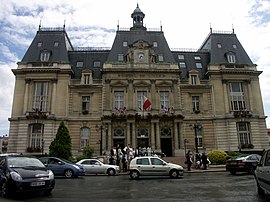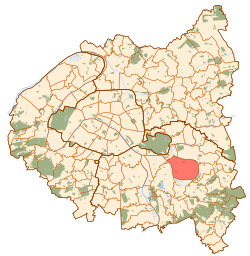Saint-Maur-des-Fossés (French pronunciation: [sɛ̃ mɔʁ de fose] ⓘ) is a commune in Val-de-Marne, the southeastern suburbs of Paris, France, 11.7 kilometres (7.3 miles) from the centre of Paris.
Saint-Maur-des-Fossés | |
|---|---|
 Town hall | |
 Paris and inner ring départements | |
| Coordinates: 48°47′58″N 2°29′59″E / 48.7994°N 2.4997°E | |
| Country | France |
| Region | Île-de-France |
| Department | Val-de-Marne |
| Arrondissement | Créteil |
| Canton | Saint-Maur-des-Fossés-1 and 2 |
| Intercommunality | Grand Paris |
| Government | |
| • Mayor (2020–2026) | Sylvain Berrios[1] |
Area 1 | 11.25 km2 (4.34 sq mi) |
| Population (2022)[2] | 76,010 |
| • Density | 6,800/km2 (17,000/sq mi) |
| Time zone | UTC+01:00 (CET) |
| • Summer (DST) | UTC+02:00 (CEST) |
| INSEE/Postal code | 94068 /94100 (St Maur), 94210 (La Varenne) |
| Elevation | 32–53 m (105–174 ft) |
| 1 French Land Register data, which excludes lakes, ponds, glaciers > 1 km2 (0.386 sq mi or 247 acres) and river estuaries. | |
History
editAbbey
editSaint-Maur-des-Fossés owes its name to Saint-Maur Abbey, founded in 638 by Queen Nanthild, regent for her son Clovis II, at a place called Fossati in Medieval Latin and Les Fossés in modern French, meaning "the moats". This place, located at the narrow entrance of a loop where the river Marne made its way round a rocky outcrop,[3] was probably named after the moats of an ancient Celtic oppidum and later a Roman castrum; the site was known in medieval documents as Castrum Bagaudarum, at a time when the marauding Bagaudae had developed a legendary reputation as defenders of Christians against Roman persecution. Massive foundations, sited so far from a Roman frontier, were attributed by C. Jullian[4] to a temple or a villa instead. In Merovingian times, Gallo-Roman villas in the royal fisc were repeatedly donated as sites for monasteries under royal patronage.
The abbey, dedicated to Saint Peter, Saint Paul and the Virgin Mary, was called Sanctus Petrus Fossatensis in Medieval Latin (Saint Pierre des Fossés in French), meaning "Saint Peter of the Moats".[citation needed] It was founded by Blidegisil, archdeacon of Paris, in 638. One of the early abbots was Saint Babolen (died c. 671).[5] In 868, King Charles the Bald invited the monks of the Abbey of Saint-Maur de Glanfeuil (in Le Thoureil, Maine-et-Loire, western France), who had fled their abbey due to Viking invasion, to relocate to Saint Pierre des Fossés with their precious relics of Saint Maurus.
Later in the Middle Ages, the relics of Saint Maurus became very famous as they were supposed to heal gout and epilepsy, and Saint Pierre des Fossés became one of the most famous pilgrimage centers of medieval France. The rededication to Saint Maurus, in which abbey was renamed Saint-Maur-des-Fossés ("Saint Maurus of the Moats"), was justified by the story that during a drought in 1137, prayers to the Virgin and Saints Peter and Paul having been ineffective, prayer to Saint Maur brought the needed rainfall.[6]
Château
editThe abbey was secularised in 1535, and in 1541, the architect Philibert Delorme designed a château on the site for Cardinal Jean du Bellay, bishop of Paris, on four ranges of building around a square central court. Catherine de' Medici was a frequent visitor, preferring it to the château de Vincennes; in 1563 she acquired this "château du Bellay", and substantially rebuilt it. On September 23, 1568, her teenage son, King Charles IX, issued the Edict of Saint-Maur, which prohibited all religions but Catholicism. It prompted fierce religious intolerance in Paris and eventually led to the 1572, St. Bartholomew's Day massacre. Building projects at the site were only interrupted by Catherine's death (1589); the château was sold to the Condé family and was eventually completed, and furnished with extensive parterres, at the end of the seventeenth century.
architect: Philibert de l'Orme
The Château de Saint-Maur, still in the possession of the Condé family, was nationalised during the French Revolution, emptied of its contents, and its terrains divided up among real-estate speculators. The structure was demolished for the value of its materials; virtually nothing remains.
Village
editThe little settlement that grew around the abbey, known as Saint-Maur-des-Fossés, developed a market during the thirteenth century.[3] The present territory also includes a formerly distinct village, La Varenne-Saint-Hilaire, against the perimeter of the nearby game preserve of Saint-Hilaire, part of the abbey's domaines.
In 1791, part of the territory of Saint-Maur-des-Fossés was detached and became the commune of La Branche-du-Pont-de-Saint-Maur, later renamed Joinville-le-Pont.
After the abbey itself was abandoned, its church providing building materials in the town. During the French Revolution, Saint-Maur-des-Fossés was temporarily renamed Vivant-sur-Marne (meaning "Alive upon Marne") in a gesture of rejection of religion.
After the Revolution, the official name of the commune was simply Saint-Maur; it is only in 1897 that "des-Fossés" was re-added to the name, probably to conform to the historical name and also to distinguish Saint-Maur-des-Fossés from other communes of France also called Saint-Maur. In 1924, a few vestiges of the abbey were collected in the newly established Musée du vieux Saint-Maur.
Notable residents
editPhilippe Diolé (1908 – 1977), diver, writer and explorer, was born in Saint-Maur-des-Fossés.[7]
Roland Douce (1939–2018), plant biologist, was born in Saint-Maur-des-Fossés.
Fabien Giroix (born 17 September 1960 in Saint-Maur-des-Fossés) is a French racing driver.
Manu Katché (born 27 October 1958 in Saint-Maur-des-Fossés) is a French drummer and songwriter.
Vincenzo Peruggia (1881–1925), an Italian thief who stole the Mona Lisa on 21 August 1911, died in Saint-Maur-des-Fossés.[8]
Laurent Pimond (born 6 April 1965 in Saint-Maur-des-Fossés) is a former French footballer.[9]
Germaine Tailleferre (1892–1983) was the only woman in the group of composers known as Les Six.[10]
Geography
editSaint-Maur-des-Fossés is almost entirely surrounded by a loop of the river Marne.
Demographics
editPopulation
edit
|
| |||||||||||||||||||||||||||||||||||||||||||||||||||||||||||||||||||||||||||||||||||||||||||||||||||||||||||||||||||||
| ||||||||||||||||||||||||||||||||||||||||||||||||||||||||||||||||||||||||||||||||||||||||||||||||||||||||||||||||||||||
| Source: EHESS[11] and INSEE (1968-2017)[12] | ||||||||||||||||||||||||||||||||||||||||||||||||||||||||||||||||||||||||||||||||||||||||||||||||||||||||||||||||||||||
Immigration
edit| Born in metropolitan France | Born outside metropolitan France | |||
|---|---|---|---|---|
| 85.0% | 15.0% | |||
| Born in overseas France |
Born in foreign countries with French citizenship at birth1 | EU-15 immigrants2 | Non-EU-15 immigrants | |
| 0.7% | 3.6% | 5.2% | 5.5% | |
| 1 This group is made up largely of former French settlers, such as pieds-noirs in Northwest Africa, followed by former colonial citizens who had French citizenship at birth (such as was often the case for the native elite in French colonies), as well as to a lesser extent foreign-born children of French expatriates. A foreign country is understood as a country not part of France in 1999, so a person born for example in 1950 in Algeria, when Algeria was an integral part of France, is nonetheless listed as a person born in a foreign country in French statistics. 2 An immigrant is a person born in a foreign country not having French citizenship at birth. An immigrant may have acquired French citizenship since moving to France, but is still considered an immigrant in French statistics. On the other hand, persons born in France with foreign citizenship (the children of immigrants) are not listed as immigrants. | ||||
Politics
editSaint-Maur leans to the right in presidential elections, giving François Fillon 33% of its votes in the first round of the 2017 French presidential election.
| Election | Winning candidate | Party | % | |
|---|---|---|---|---|
| 2022 | Emmanuel Macron | EM | 76.74 | |
| 2017 | Emmanuel Macron | EM | 82.56 | |
| 2012 | Nicolas Sarkozy | UMP | 59.76 | |
| 2007 | Nicolas Sarkozy | UMP | 64.66 | |
| 2002 | Jacques Chirac | RPR | 86.46 | |
| 1995 | Jacques Chirac | RPR | 66.90 | |
Transport
editSaint-Maur-des-Fossés is served by four stations on Paris RER line A: Saint-Maur – Créteil, Le Parc de Saint-Maur, Champigny, and La Varenne – Chennevières.
Saint-Maur-des-Fossés is also served by many buses, like the TVM (Trans-Val-de-Marne), where Saint-Maur-Créteil is one of the bus terminal.
Education
editThere are 25 public preschools (écoles maternelles) and primary schools in the commune.[13]
Public junior high schools:
Public senior high schools:
- Lycée Marcelin Berthelot[16]
- Lycée d'Arsonval
- Lycée Condorcet
Private schools:
- Ensemble scolaire Saint-André (preschool through junior high school)[17]
- Ecole et collège Jeanne D'Arc[18]
- Lycée Teilhard de Chardin[19]
Culture
editFestivals
editSaint-Maur-des-Fossés organizes an annual Short Subject Festival.
Film and literature
editSaint-Maur-des-Fossés was the filming location for the old-Paris sections of the 1958 Academy award winning film Mon Oncle by Jacques Tati.[20] A statue of Tati in character as Monsieur Hulot along with two other characters from the film is visible in the Commune at Place d'Arme.[21]
Sport
editUS Lusitanos Saint-Maur was founded in 1966 by Portuguese immigrants who worked in a factory in the town. They play their games at the Stade Adolphe-Chéron.
Twin towns - sister cities
editSaint-Maur-des-Fossés is twinned with:[22]
- Ramat HaSharon, Israel
- Bognor Regis, United Kingdom
- Rimini, Italy
- La Louvière, Belgium
- Ziguinchor, Senegal
- Hamelin, Germany
- Leiria, Portugal
- Pforzheim, Germany
See also
editReferences
edit- ^ "Répertoire national des élus: les maires" (in French). data.gouv.fr, Plateforme ouverte des données publiques françaises. 13 September 2022.
- ^ "Populations de référence 2022" (in French). The National Institute of Statistics and Economic Studies. 19 December 2024.
- ^ a b "Saint-Maur au fil du temps" Archived October 12, 2007, at the Wayback Machine
- ^ C. Jullian discussed the medieval reputation of Bagaudes and the archaeology of the Saint-Maur site in Revue des Études Anciennes 22 (1920:07-17), noted by Sidney J. Deane, "Archaeological Discussions", American Journal of Archaeology 25.2 (April 1921:195.)
- ^ O'Hanlon, John (1875), Lives of the Irish Saints : with special festivals, and the commemorations of holy persons, Dublin: J. Duffy, p. 806, retrieved 2021-08-22
- ^ Virginia Wylie Egbert, "St. Nicholas: The Fasting Child" The Art Bulletin 46.1 (March 1964:69-70) p. 69 note 4.
- ^ Philippe Diolé, BNF official record
- ^ (in Italian) Mio padre, il ladro della Gioconda
- ^ "Laurent PIMOND". Histoire du #PSG. 30 May 2017. Retrieved 28 July 2020.
- ^ Shapiro, Robert (2011). Les Six: the French composers and their mentors, Jean Cocteau and Erik Satie. London: Peter Owen. ISBN 9780720612936.
- ^ Des villages de Cassini aux communes d'aujourd'hui: Commune data sheet Saint-Maur-des-Fossés, EHESS (in French).
- ^ Population en historique depuis 1968, INSEE
- ^ "Enfance Archived 2016-10-16 at the Wayback Machine." Saint-Maur-des-Fossés. Retrieved on September 6, 2016.
- ^ Home Archived 2017-11-12 at the Wayback Machine. Collège Le Parc. Retrieved on September 6, 2016.
- ^ Home. Collège Rabelais. Retrieved on September 6, 2016.
- ^ Home. Lycée Marcelin Berthelot. Retrieved on September 6, 2016.
- ^ Home. Ensemble scolaire Saint-André. Retrieved on September 6, 2016.
- ^ Home. Ecole et collège Jeanne D'Arc. Retrieved on September 6, 2016.
- ^ Home. Lycée Teilhard de Chardin. Retrieved on September 6, 2016.
- ^ "Mon Oncle (1958) - IMDb". IMDb.
- ^ "Mon Oncle - Hommage à Jacques Tati (Saint-Maur-des-Fosses) - 2021 All You Need to Know BEFORE You Go (With Photos)".
- ^ "Découvrez Saint-Maur". saint-maur.com (in French). Saint-Maur-des-Fossés. Archived from the original on 2016-12-26. Retrieved 2019-11-18.
External links
edit- City Website (in French)
- . Encyclopædia Britannica. Vol. 24 (11th ed.). 1911. p. 31.
- Historical and Archaeological Association
- Site des conseillers municipaux de l'opposition (PS-PC)



